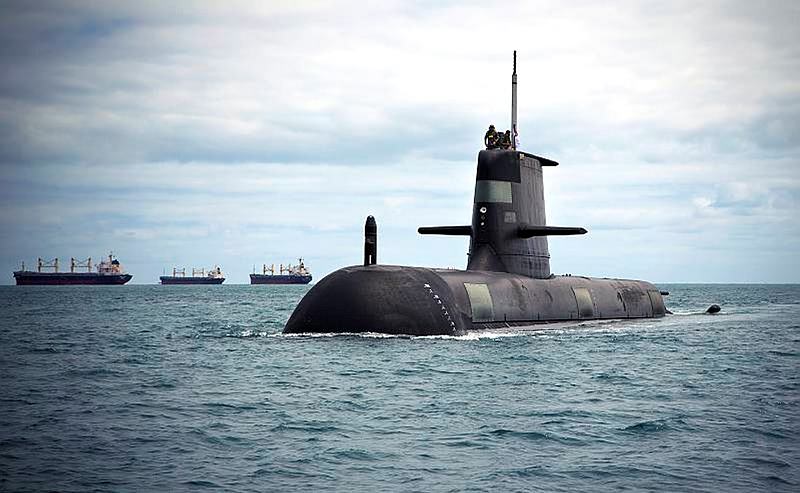When the government says ‘competitive evaluation tender process’…
Posted By Andrew Davies on February 11, 2015 @ 16:40
 [1]
[1]We’ve written a lot about the future submarine project over the years. Last year, Mark Thomson and I surveyed the possible range of acquisition strategies [2] the government could opt to pursue. We made the observation then that any
… project that’s going to spend billions of taxpayers’ dollars over decades will require bipartisan support, so efforts should be made to ensure that there’s a political consensus. And the public deserves to have enough information to at least understand why and how the money is to be spent.
We’re a long way away from either of those aspirations now. The public discussion of what’s being described as a ‘competitive evaluation process’ (without any working definition of what that phrase means) has turned an already opaque situation into one that’s now also politically charged. So let’s reiterate what we know.
Whatever happens, this isn’t going to be a straightforward purchase. It’s clear from a series of commissioned studies that while we have an in-country capability for building and maintaining submarines, Australia doesn’t have the wherewithal to design and build a submarine from the ground up without substantial assistance from an established offshore design house.
Before this weekend, most watchers of the process (including me [3]) were of the view that the government’s preferred option was collaboration with Japan, which would see a modified version of the Japanese Navy’s Soryu-class submarines built for Australia. That option seemed to be developing momentum, based in no small part on a strong relationship between Prime Ministers Abbott and Abe [4]. And it was seen as part of a deepening strategic relationship between the two countries.
In fact, it would almost certainly be a three-way arrangement because Australia has a strong preference for including American combat- and weapon-systems into our subs. They aren’t standard fits in the Soryu boats—the Japanese have a combination of their own bespoke systems and some licenced European technologies. Fitting American systems into a Japanese submarine would require some redesign work, and the three governments would have to agree to the arrangement.
If we can make that work, it’s not clear how much work would be available to Australian industry. The Japanese yards are extremely efficient and it would make sense to build the hulls there. Perhaps there’d be some scope for doing the final fitting-out of the submarines here, as is being done with the new amphibious ships. But submarines are much more tightly integrated than large surface ships, so it’s not clear that enough would be gained to balance the risks taken on.
The fall-back option would be to run a more conventional acquisition competition, in which design houses from France, Germany and Sweden compete for Australia’s business. Each of those countries is an established exporter of arms and routinely compete for international business, so that would be a relatively straightforward exercise for them. All three countries have been busy pitching their offerings to the Australian government and each of them would be looking at ways of involving Australian industry in the project to sweeten the deal politically. In that sort of arrangement, it’d make sense for the Australian government’s own naval shipbuilder ASC to partner with the foreign designer to bid for work share—as seems to be the case the government is now pushing. Alternatively, the government could require all bidders to partner with, or perhaps take over, ASC.
Japan’s a different story. It’s taking very early steps towards becoming a defence exporter, and to date hasn’t exported any equipment of note. Japan would be going from ‘zero to sixty’ in exporting something as sophisticated and sensitive as a submarine, and political and perhaps even constitutional constraints would have to be negotiated. That’s why a strong government-to-government relationship would have to underpin any deal with Japan.
If Japan is indeed the preferred option, it’s hardly likely that Tokyo will consider the ‘opening up’ of the Australian submarine project to other nations a welcome development. The most likely effect of a competition (and of the party political divide opening up in Australia) would be a reduction of Japanese enthusiasm for involvement [5]. If that falls through, we’d be again looking to Europe—back to where we were before the Japanese option reared its head.
I think we can reasonably infer that the government wants to keep the Japanese option available, and that it might still be the preferred option. If that wasn’t the case, it’s hard to explain why it has chosen to endure the political pain of the past 48 hours [6] (cartoon) rather than cutting it off with a crisp announcement of how a restricted tender (there was never going to be an open tender for submarines) would work and what sort of industrial arrangements the government would be seeking to put in place.
Alas, bipartisanship and transparency seem an even more distant prospect than was the case even a few months ago.
This article expands on an opinion piece published in the Australian Financial Review [7] on 11 February.
Andrew Davies [8] is senior analyst for defence capability and director of research at ASPI. Image courtesy of Department of Defence [9].
Article printed from The Strategist: https://www.aspistrategist.org.au
URL to article: https://www.aspistrategist.org.au/when-the-government-says-competitive-evaluation-process/
URLs in this post:
[1] Image: http://www.aspistrategist.org.au/wp-content/uploads/2015/02/20141106ran8566787_071.jpg
[2] surveyed the possible range of acquisition strategies: http://www.aspistrategist.org.au/how-to-buy-a-submarine-part-2/
[3] including me: http://www.aspistrategist.org.au/?s=%2Bjapan+%2Bsubmarine
[4] a strong relationship between Prime Ministers Abbott and Abe: http://www.news.com.au/national/australia-to-sign-new-submarines-deal-with-japan-as-prime-minister-shinzo-abe-visits-tony-abbott-in-canberra/story-fncynjr2-1226980720135
[5] reduction of Japanese enthusiasm for involvement: http://www.lowyinterpreter.org/post/2015/02/11/Abbotts-submarine-about-face-is-bad-news-for-Shinzo-Abe.aspx?COLLCC=870897180&
[6] political pain of the past 48 hours: http://www.theage.com.au/national/cartoons-for-wednesday-february-11-20150210-13b1ji.html
[7] opinion piece published in the Australian Financial Review: https://www.aspi.org.au/publications/opinion-pieces/submarines-buying-process-sub-standard
[8] Andrew Davies: https://www.aspi.org.au/about-aspi/aspi-staff/senior-analysts/andrew-davies
[9] Department of Defence: http://images.defence.gov.au/20141106ran8566787_071.jpg
Click here to print.